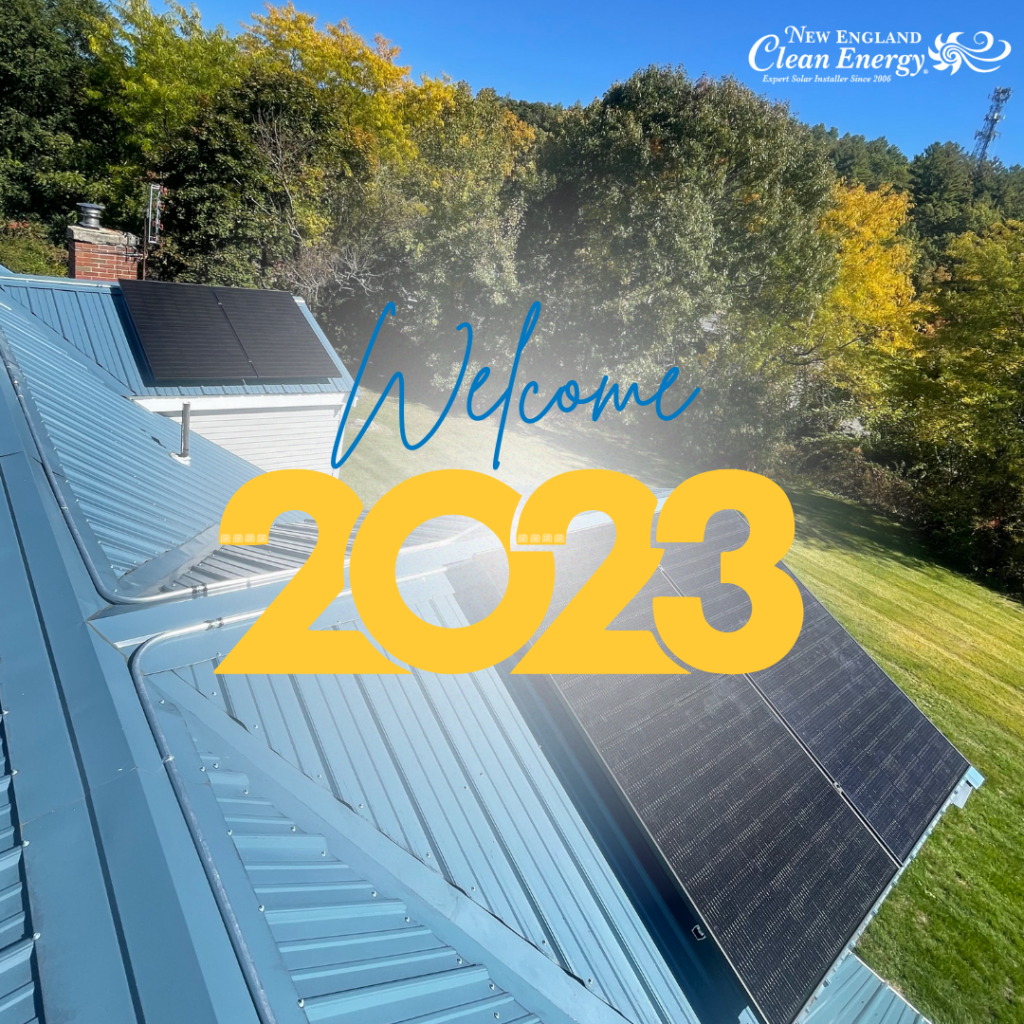2022 was a breakout year for solar. The Inflation Reduction Act, which kept the ITC at 30% as well as a major increase in the cost of electricity, made it possible for solar to become even more of a lower-cost alternative to traditional energy sources.
But is solar now the new normal?
Solar energy has been growing steadily since its inception and is expected to continue doing so in the years ahead. However, we believe that 2022 will be remembered for the year when the solar industry went mainstream.
In 2022 here at New England Clean Energy Inc, we helped many customers; we installed new solar panel and battery installations as well as maintenance services across New England. This includes commercial “for-profit” customers, nonprofit customers, and of course our largest customer base, residential homeowners. Breaking it down further we installed:
- Solar powered installations ranging from 2.5kW to 207 kW
- A median system size of 8-9 kW
- System components that include Enphase microinverters, REC panels, as well as products from SolarEdge, Generac, and Qcells
In general, according to a 2022 report by the SEIA: Massachusetts, Rhode Island, and New Hampshire rank 20th, 33rdth, and 37th for percentage of state electricity used from solar. Around 833,590 homes are now powered by solar in those three states. From SEIA’s US Solar Market Insight Executive summary we can estimate about 15,000 solar installations were put up in Mass, New Hampshire, and Rhode Island in 2022. And we are extremely excited to be a part of that growth.
How We Helped with Energy Savings:
The size and design of a solar powered installation vary depending on the needs of the customer. However, we can estimate first-year savings using data from an example proposal of an 8.5 kW system in our own estimator.
According to our estimator, an 8.5 kW system will save you about $2,162 annually. Meaning, the 15,000 customers who have gone solar will have saved a total of around $32.4 million.
Then, if you take into consideration the 25+ year lifespan of our solar systems, an 8.5 kW system will save you around $54,050 and will save solar customers a total of $810.8 million.
And, with the help of incentives like the 30% Solar Federal Credit, our customers have saved even MORE money. For more information on incentives you can qualify for check out our state specific blog posts for Massachusetts, Rhode Island, and New Hampshire. You can also always check out our own deals. We currently have our 2023 System Size Winter Discount running!
How We Helped with The Environment:
Saving on your electricity bill isn’t the only benefit of a solar installation. Many of our customers install panels for environmental benefits, too. A cool way to understand these numbers is to equate this data to the ultimate carbon-sequestering powerhouses: trees.
According to a past article of ours titled “Tree Math 2: Solar vs. Trees, What’s the Carbon Trade-off?” 1kWh hour of fossil fuel generated electricity produces around 1.106 pounds of CO2. That’s 6.636 pounds of C02 offset by a typical 6kW system per hour.
Using this environmental data, let’s calculate the total carbon offset of a 6kW system: Our system makes around 12,000kwH a year, so at 1.106 lbs of CO2 per kW hour, we will prevent 79,632 pounds of CO2 from being released each year. With the 15,000 systems installed in 2022, the cumulative carbon offset totals 1.2 billion pounds of CO2 per year and 29.9 billion pounds of CO2 over these systems’ 25-year life span.
According to SavingNature.com, a mature tree absorbs about 31 pounds of carbon dioxide a year. Thus, the estimated 15,000 solar power systems installed in 2022 will offset as much CO2 in their lifetime as 963.3 million mature trees.
How We Helped The Community:
In 2022, New England Clean Energy Inc. continued to work with community-centric non-profit organizations. In the past, we have worked with the Westport River Watershed Alliance and the Worcester Common Ground. As well as wildlife sanctuaries and parks!
Last year we installed solar at St John The Evangelist Church in Duxbury, MA. 
Solar powered systems reduce electricity and operating costs for these organizations, allowing them to re-allocate that money to projects that support their mission. They can continue to serve their community without the annoyance of expensive electricity bills!
We can only hope 2023 will top 2022. But more than anything, we’re happy that we were able to reduce our customers’ bills, offset some nasty carbon dioxide, and help lots of individuals and nonprofits realize their solar dreams. But did 2022 put solar on course to be a standard for every roof? We hope so! We certainly think solar should be for everyone.
Interested in what solar can do for you in 2023? Get an instant ballpark estimate from us today at no cost to you.
If you liked this article, you may also like:
How Does The Solar Tax Credit Work?





